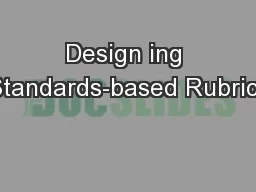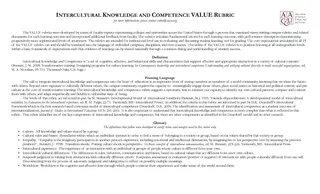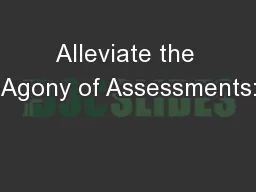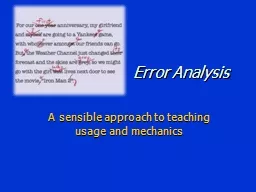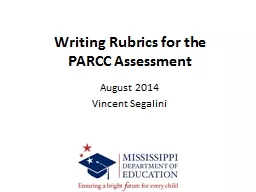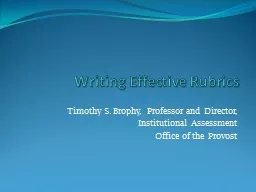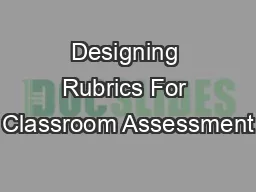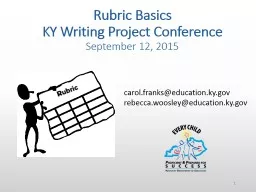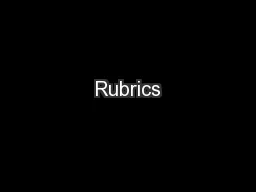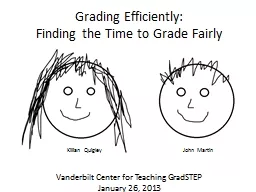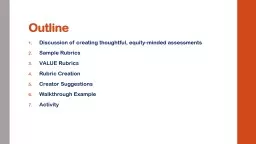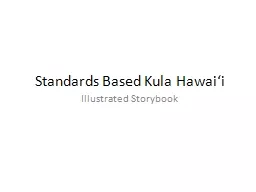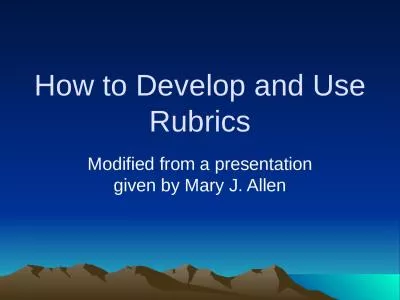PPT-Design ing Standards-based Rubrics
Author : pasty-toler | Published Date : 2018-02-11
KY Writing Project Conference September 2015 1 carolfrankseducationkygov rebeccawoosleyeducationkygov Sit with your grade level Our Targets I can design a quality
Presentation Embed Code
Download Presentation
Download Presentation The PPT/PDF document "Design ing Standards-based Rubrics" is the property of its rightful owner. Permission is granted to download and print the materials on this website for personal, non-commercial use only, and to display it on your personal computer provided you do not modify the materials and that you retain all copyright notices contained in the materials. By downloading content from our website, you accept the terms of this agreement.
Design ing Standards-based Rubrics: Transcript
KY Writing Project Conference September 2015 1 carolfrankseducationkygov rebeccawoosleyeducationkygov Sit with your grade level Our Targets I can design a quality rubric congruent to expectations of grade level standards. Teacher Rubric January 2012 Massachusetts Department of Elementary and Secondary Education 75 Pleasant Street Malden MA02148 4906 Phone 781 338 3000 TTY NET Relay 800 439 2370 wwwdoemassedu brPage 2br Guide to Teacher Rubric Part III Appendix ESE M The rubrics articulate fundamental cri teria for each learning outcome with performance descriptors demonstrating prog ressively more sophisticated levels of attainment The rubrics are intended for institutional level use in evaluating and discussin Tips, Test Banks, Online Rubrics, and State Exams. Overview. Assessments in general. Tests. Rubrics. Supporting state exams. A portion of The Curriculum Center’s past two years project has been on assessments.. A sensible approach to teaching usage and mechanics. Error Analysis. “We have begun to view errors as exceptionally interesting clues about what is going on in our students’ minds, as clues to the linguistic and cognitive processes that function unobserved.” . PARCC Assessment. August. . 2014. Vincent Segalini. DISCLAIMER!. The writing rubrics for the PARCC assessment were created to score on-demand writing tasks for an assessment. They are more general than writing rubrics that would be used to score writing in the classroom. Remember:. Announcements. First classroom-based assessment due . in two weeks . – it can be ANY type of criterion-referenced assessment. Kudos if you use some type of electronic recording system (see outline for links).. . Timothy S. Brophy, Professor and Director, Institutional Assessment. Office of the Provost. Goals:. Introduce . the basic design principles for creating rubrics. Introduces rubric types. Present . Professor Timothy . Farnsworth, CUNY . Hunter . College. Communicative Assessment Is Hard!. We are making inferences about what people can and can’t get done in the real world, not: . What grammar or vocabulary they can choose from 4 options on a MC test. KY Writing Project Conference. September . 12, 2015. 1. carol.franks@education.ky.gov. rebecca.woosley@education.ky.gov. TARGETS. I can evaluate rubrics for quality.. I can identify when a rubric is congruent to expectations of grade level standards.. What is a rubric?. An evaluation tool. As simple as a checklist (holistic) to highly complex (analytic). Quality control. Provide feedback for areas of improvement. Can be developed and used by students, instructors, & administrators. Finding the Time to Grade Fairly. Killian Quigley. John Martin. Vanderbilt Center for Teaching . GradSTEP. January 26, 2013. Challenges. The “What” and “Why” of Grading. Time Management. Rubrics. We VALUE HIPs Utilizing VALUE Rubrics and HIP QA Tools in Course Revitalization Presented by Melynda Conner, TBR OSS HIP Specialist 2019 Workshop Prep What is your favorite class to teach? What is your Illustrated Storybook. 1887. 1996. Three campuses thrive . . . . Illumination!. Änuenue. !. , Tri Campus . Kökua. ?. ‘. Ae. ! . All KS graduates to excel as Hawaiians in the 21. st. century?. ‘. Modified from a presentation given by Mary J. Allen. Rubrics can be used to classify student essays, research reports, projects, performances, works of art, oral presentations, portfolios, and group activities. They are powerful tools that can both give feedback to students as well as collect data for assessment..
Download Document
Here is the link to download the presentation.
"Design ing Standards-based Rubrics"The content belongs to its owner. You may download and print it for personal use, without modification, and keep all copyright notices. By downloading, you agree to these terms.
Related Documents

